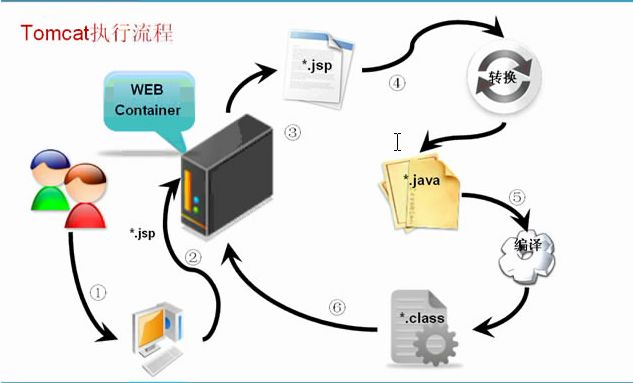javaweb学习总结(十四)——JSP原理
一、什么是JSP?
JSP全称是Java Server Pages,它和servle技术一样,都是SUN公司定义的一种用于开发动态web资源的技术。
JSP这门技术的最大的特点在于,写jsp就像在写html,但它相比html而言,html只能为用户提供静态数据,而Jsp技术允许在页面中嵌套java代码,为用户提供动态数据。
二、JSP原理
2.1、Web服务器是如何调用并执行一个jsp页面的?
浏览器向服务器发请求,不管访问的是什么资源,其实都是在访问Servlet,所以当访问一个jsp页面时,其实也是在访问一个Servlet,服务器在执行jsp的时候,首先把jsp翻译成一个Servlet,所以我们访问jsp时,其实不是在访问jsp,而是在访问jsp翻译过后的那个Servlet,例如下面的代码:
index.jsp
1 <%@ page language="java" import="java.util.*" pageEncoding="UTF-8"%> 2 <% 3 String path = request.getContextPath(); 4 String basePath = request.getScheme()+"://"+request.getServerName()+":"+request.getServerPort()+path+"/"; 5 %> 6 7 <!DOCTYPE HTML PUBLIC "-//W3C//DTD HTML 4.01 Transitional//EN"> 8 <html> 9 <head> 10 <base href="<%=basePath%>"> 11 12 <title>First Jsp</title> 13 14 </head> 15 16 <body> 17 <% 18 out.print("Hello Jsp"); 19 %> 20 </body> 21 </html>
当我们通过浏览器访问index.jsp时,服务器首先将index.jsp翻译成一个index_jsp.class,在Tomcat服务器的work\Catalina\localhost\项目名\org\apache\jsp目录下可以看到index_jsp.class的源代码文件index_jsp.java,index_jsp.java的代码如下:
1 package org.apache.jsp; 2 3 import javax.servlet.*; 4 import javax.servlet.http.*; 5 import javax.servlet.jsp.*; 6 import java.util.*; 7 8 public final class index_jsp extends org.apache.jasper.runtime.HttpJspBase 9 implements org.apache.jasper.runtime.JspSourceDependent { 10 11 private static final JspFactory _jspxFactory = JspFactory.getDefaultFactory(); 12 13 private static java.util.List _jspx_dependants; 14 15 private javax.el.ExpressionFactory _el_expressionfactory; 16 private org.apache.AnnotationProcessor _jsp_annotationprocessor; 17 18 public Object getDependants() { 19 return _jspx_dependants; 20 } 21 22 public void _jspInit() { 23 _el_expressionfactory = _jspxFactory.getJspApplicationContext(getServletConfig().getServletContext()).getExpressionFactory(); 24 _jsp_annotationprocessor = (org.apache.AnnotationProcessor) getServletConfig().getServletContext().getAttribute(org.apache.AnnotationProcessor.class.getName()); 25 } 26 27 public void _jspDestroy() { 28 } 29 30 public void _jspService(HttpServletRequest request, HttpServletResponse response) 31 throws java.io.IOException, ServletException { 32 33 PageContext pageContext = null; 34 HttpSession session = null; 35 ServletContext application = null; 36 ServletConfig config = null; 37 JspWriter out = null; 38 Object page = this; 39 JspWriter _jspx_out = null; 40 PageContext _jspx_page_context = null; 41 42 43 try { 44 response.setContentType("text/html;charset=UTF-8"); 45 pageContext = _jspxFactory.getPageContext(this, request, response, 46 null, true, 8192, true); 47 _jspx_page_context = pageContext; 48 application = pageContext.getServletContext(); 49 config = pageContext.getServletConfig(); 50 session = pageContext.getSession(); 51 out = pageContext.getOut(); 52 _jspx_out = out; 53 54 out.write('\r'); 55 out.write('\n'); 56 57 String path = request.getContextPath(); 58 String basePath = request.getScheme()+"://"+request.getServerName()+":"+request.getServerPort()+path+"/"; 59 60 out.write("\r\n"); 61 out.write("\r\n"); 62 out.write("<!DOCTYPE HTML PUBLIC \"-//W3C//DTD HTML 4.01 Transitional//EN\">\r\n"); 63 out.write("<html>\r\n"); 64 out.write(" <head>\r\n"); 65 out.write(" <base href=\""); 66 out.print(basePath); 67 out.write("\">\r\n"); 68 out.write(" \r\n"); 69 out.write(" <title>First Jsp</title>\r\n"); 70 out.write("\t\r\n"); 71 out.write(" </head>\r\n"); 72 out.write(" \r\n"); 73 out.write(" <body>\r\n"); 74 out.write(" "); 75 76 out.print("Hello Jsp"); 77 78 out.write("\r\n"); 79 out.write(" </body>\r\n"); 80 out.write("</html>\r\n"); 81 } catch (Throwable t) { 82 if (!(t instanceof SkipPageException)){ 83 out = _jspx_out; 84 if (out != null && out.getBufferSize() != 0) 85 try { out.clearBuffer(); } catch (java.io.IOException e) {} 86 if (_jspx_page_context != null) _jspx_page_context.handlePageException(t); 87 } 88 } finally { 89 _jspxFactory.releasePageContext(_jspx_page_context); 90 } 91 } 92 }
我们可以看到,index_jsp这个类是继承 org.apache.jasper.runtime.HttpJspBase这个类的,通过查看Tomcat服务器的源代码,可以知道在apache-tomcat-6.0.20-src\java\org\apache\jasper\runtime目录下存HttpJspBase这个类的源代码文件,如下图所示:
我们可以看看HttpJsBase这个类的源代码,如下所示:
1 /* 2 * Licensed to the Apache Software Foundation (ASF) under one or more 3 * contributor license agreements. See the NOTICE file distributed with 4 * this work for additional information regarding copyright ownership. 5 * The ASF licenses this file to You under the Apache License, Version 2.0 6 * (the "License"); you may not use this file except in compliance with 7 * the License. You may obtain a copy of the License at 8 * 9 * http://www.apache.org/licenses/LICENSE-2.0 10 * 11 * Unless required by applicable law or agreed to in writing, software 12 * distributed under the License is distributed on an "AS IS" BASIS, 13 * WITHOUT WARRANTIES OR CONDITIONS OF ANY KIND, either express or implied. 14 * See the License for the specific language governing permissions and 15 * limitations under the License. 16 */ 17 18 package org.apache.jasper.runtime; 19 20 import java.io.IOException; 21 22 import javax.servlet.ServletConfig; 23 import javax.servlet.ServletException; 24 import javax.servlet.http.HttpServlet; 25 import javax.servlet.http.HttpServletRequest; 26 import javax.servlet.http.HttpServletResponse; 27 import javax.servlet.jsp.HttpJspPage; 28 import javax.servlet.jsp.JspFactory; 29 30 import org.apache.jasper.compiler.Localizer; 31 32 /** 33 * This is the super class of all JSP-generated servlets. 34 * 35 * @author Anil K. Vijendran 36 */ 37 public abstract class HttpJspBase 38 extends HttpServlet 39 implements HttpJspPage 40 41 42 { 43 44 protected HttpJspBase() { 45 } 46 47 public final void init(ServletConfig config) 48 throws ServletException 49 { 50 super.init(config); 51 jspInit(); 52 _jspInit(); 53 } 54 55 public String getServletInfo() { 56 return Localizer.getMessage("jsp.engine.info"); 57 } 58 59 public final void destroy() { 60 jspDestroy(); 61 _jspDestroy(); 62 } 63 64 /** 65 * Entry point into service. 66 */ 67 public final void service(HttpServletRequest request, HttpServletResponse response) 68 throws ServletException, IOException 69 { 70 _jspService(request, response); 71 } 72 73 public void jspInit() { 74 } 75 76 public void _jspInit() { 77 } 78 79 public void jspDestroy() { 80 } 81 82 protected void _jspDestroy() { 83 } 84 85 public abstract void _jspService(HttpServletRequest request, 86 HttpServletResponse response) 87 throws ServletException, IOException; 88 }
HttpJspBase类是继承HttpServlet的,所以HttpJspBase类是一个Servlet,而index_jsp又是继承HttpJspBase类的,所以index_jsp类也是一个Servlet,所以当浏览器访问服务器上的index.jsp页面时,其实就是在访问index_jsp这个Servlet,index_jsp这个Servlet使用_jspService这个方法处理请求。
2.2、Jsp页面中的html排版标签是如何被发送到客户端的?
浏览器接收到的这些数据
1 <!DOCTYPE HTML PUBLIC "-//W3C//DTD HTML 4.01 Transitional//EN"> 2 <html> 3 <head> 4 <base href="http://localhost:8080/JavaWeb_Jsp_Study_20140603/"> 5 6 <title>First Jsp</title> 7 8 </head> 9 10 <body> 11 Hello Jsp 12 </body> 13 </html>
都是在_jspService方法中使用如下的代码输出给浏览器的:
1 out.write('\r'); 2 out.write('\n'); 3 4 String path = request.getContextPath(); 5 String basePath = request.getScheme()+"://"+request.getServerName()+":"+request.getServerPort()+path+"/"; 6 7 out.write("\r\n"); 8 out.write("\r\n"); 9 out.write("<!DOCTYPE HTML PUBLIC \"-//W3C//DTD HTML 4.01 Transitional//EN\">\r\n"); 10 out.write("<html>\r\n"); 11 out.write(" <head>\r\n"); 12 out.write(" <base href=\""); 13 out.print(basePath); 14 out.write("\">\r\n"); 15 out.write(" \r\n"); 16 out.write(" <title>First Jsp</title>\r\n"); 17 out.write("\t\r\n"); 18 out.write(" </head>\r\n"); 19 out.write(" \r\n"); 20 out.write(" <body>\r\n"); 21 out.write(" "); 22 23 out.print("Hello Jsp"); 24 25 out.write("\r\n"); 26 out.write(" </body>\r\n"); 27 out.write("</html>\r\n");
在jsp中编写的java代码和html代码都会被翻译到_jspService方法中去,在jsp中编写的java代码会原封不动地翻译成java代码,如<%out.print("Hello Jsp");%>直接翻译成out.print("Hello Jsp");,而HTML代码则会翻译成使用out.write("<html标签>\r\n");的形式输出到浏览器。在jsp页面中编写的html排版标签都是以out.write("<html标签>\r\n");的形式输出到浏览器,浏览器拿到html代码后才能够解析执行html代码。
2.3、Jsp页面中的java代码服务器是如何执行的?
在jsp中编写的java代码会被翻译到_jspService方法中去,当执行_jspService方法处理请求时,就会执行在jsp编写的java代码了,所以Jsp页面中的java代码服务器是通过调用_jspService方法处理请求时执行的。
2.4、Web服务器在调用jsp时,会给jsp提供一些什么java对象?
查看_jspService方法可以看到,Web服务器在调用jsp时,会给Jsp提供如下的8个java对象
1 PageContext pageContext; 2 HttpSession session; 3 ServletContext application; 4 ServletConfig config; 5 JspWriter out; 6 Object page = this; 7 HttpServletRequest request, 8 HttpServletResponse response
其中page对象,request和response已经完成了实例化,而其它5个没有实例化的对象通过下面的方式实例化
1 pageContext = _jspxFactory.getPageContext(this, request, response,null, true, 8192, true); 2 application = pageContext.getServletContext(); 3 config = pageContext.getServletConfig(); 4 session = pageContext.getSession(); 5 out = pageContext.getOut();
这8个java对象在Jsp页面中是可以直接使用的,如下所示:
1 <% 2 session.setAttribute("name", "session对象");//使用session对象,设置session对象的属性 3 out.print(session.getAttribute("name")+"<br/>");//获取session对象的属性 4 pageContext.setAttribute("name", "pageContext对象");//使用pageContext对象,设置pageContext对象的属性 5 out.print(pageContext.getAttribute("name")+"<br/>");//获取pageContext对象的属性 6 application.setAttribute("name", "application对象");//使用application对象,设置application对象的属性 7 out.print(application.getAttribute("name")+"<br/>");//获取application对象的属性 8 out.print("Hello Jsp"+"<br/>");//使用out对象 9 out.print("服务器调用index.jsp页面时翻译成的类的名字是:"+page.getClass()+"<br/>");//使用page对象 10 out.print("处理请求的Servlet的名字是:"+config.getServletName()+"<br/>");//使用config对象 11 out.print(response.getContentType()+"<br/>");//使用response对象 12 out.print(request.getContextPath()+"<br/>");//使用request对象 13 %>
运行结果如下:
2.5、Jsp最佳实践
Jsp最佳实践就是jsp技术在开发中该怎么去用。
不管是JSP还是Servlet,虽然都可以用于开发动态web资源。但由于这2门技术各自的特点,在长期的软件实践中,人们逐渐把servlet作为web应用中的控制器组件来使用,而把JSP技术作为数据显示模板来使用。其原因为,程序的数据通常要美化后再输出:让jsp既用java代码产生动态数据,又做美化会导致页面难以维护。让servlet既产生数据,又在里面嵌套html代码美化数据,同样也会导致程序可读性差,难以维护。因此最好的办法就是根据这两门技术的特点,让它们各自负责各的,servlet只负责响应请求产生数据,并把数据通过转发技术带给jsp,数据的显示jsp来做。
2.6、Tomcat服务器的执行流程
第一次执行:
- 客户端通过电脑连接服务器,因为是请求是动态的,所以所有的请求交给WEB容器来处理
- 在容器中找到需要执行的*.jsp文件
- 之后*.jsp文件通过转换变为*.java文件
- *.java文件经过编译后,形成*.class文件
- 最终服务器要执行形成的*.class文件
第二次执行:
- 因为已经存在了*.class文件,所以不在需要转换和编译的过程
修改后执行:
1.源文件已经被修改过了,所以需要重新转换,重新编译。
